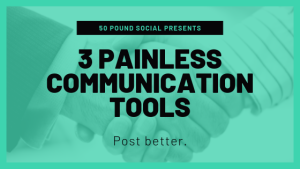Are you finding it hard lately to get as many likes and shares as you want? Creativity is at the order of the day when dealing with social networks. With all of them. We know you’re creative.
As an entrepreneur, there’s no choice.
But, unfortunately, having a bunch of bright ideas is not enough to get the real hang of social media marketing.
Apart from designing a solid content strategy and crafting your multiple posts with considerable anticipation, what you need is to be aware of certain basic communication principles.
Online communication might have some common elements with a face to face conversation, but it’s not exactly the same. Online writing is a world on its own and you have to know some rules first.
These simple language tweaks could turn your whole social media game around.
And by language and communication, I´m not only talking about words. Because it’s more complex than that. So, why not take some minutes today to read these three, thinking, and check if you’re connecting the dots right? You won’t regret it, I promise.
Let’s begin.
1. Tone and register:
Do you seriously think about the reader when you prepare all of your social media posts? The way you write your content has to be super in tune with your target audience.
Resonating with your readers is easy in social networks if you only place yourself in their shoes. But for real.
I mean, do you know their problems, have you studied their habits, their frustrations?
The same applies to their hopes and dreams.
And the choice of words has to be precise here. Are some of your social media posts super formal and others very informal? If you’re doing this, stop immediately.
Agree upon the tone of your publications. If you’re going to use contractions, always do it. And not sometimes.
Why? Because consistency is mandatory to stand out in the everyday content battle.
2. Localisation:
Localisation is the process of adapting content from one language to another, or from one variety of a language to another. There are quite a lot of localisation issues all over the internet, especially if your company posts a raft of content in multiple languages – or varieties of the same.
When we talk about localisation we don’t talk only about mere words, but also about adapting currency or graphics to convey the very same meaning to that specific culture.
For instance, American English is different from British English. A clever way to resonate with your audience on social networks is to use exactly the words as your ideal readers would. For example, in Australian English, the word “bizzo” is widely used instead of “business”.
So, if you happen to be posting for Australians, it’s advisable to use that regionalism instead of “business”. Don’t you think it’s a simple way to empathise with the users?
Or, if we take Spanish, it’s not the same to post in Spanish for Mexicans than for Colombians. Words are different for each country, or what is worse, the same word that is positive for one culture can be offensive for the other.
So, how can you solve these kinds of complex language issues?
By hiring experienced translators or doing a lot of research yourself before posting content in multiple languages.
The matter of localisation is increasingly important for online businesses since different languages are starting to gain power over the internet. We know that English has been the most global language up to the present moment.
However, in the near future, it’s going to be necessary for businesses to expand to other languages and cultures.
3. Visuals:
Even though text is still very important, images and overall design are crucial in social media content. Appealing pictures can make someone choose to read one post over another with unattractive visuals. Even though they can even feature the same text.
In just a few seconds we make choices because of images.
So, ask yourself these questions to check if you’re doing well to catch the attention of your readers:
Are you being consistent with the colors you use in social networks, the type of images you show and the fonts you choose? Do images accompany text accordingly?
If you don’t have these criteria clear, stop posting now. First, agree upon what you’re going to do as regards design and types of posts.
For example, a good idea is to use Canva in order to design social media posts easily and be more consistent with visual elements.
The downside?
If you only use the free version of Canva for social media templates, you’ll notice that all posts start looking the same.
The real challenge here is to be able to create something distinctive so people can identify your brand easily. And only content ninjas can do that on social networks.
We do know how hostile social media management can be sometimes. Better said, ALL the time.
But, let me tell you today that you can make it fully manageable for your company. And finally, you can have much more time to focus on what you really love doing.
(I don’t think that social media marketing is what really ignites you.)
So, how about embracing the power of delegating tasks like blog writing, content curation, ads, and audience research to the digital marketing experts of 50 Pound Social?
Cause we simply love doing what you find risky.
Isn’t it extraordinary?
We feature three different plans according to your budget and business goals. And if you only want blog management, this is your choice. Because navigating the waters of social media on your own can be as frustrating as rowing blindfold.
Please don’t throw yourself alone into the content marketing rapids. It’s dangerous out there.
Image Credit: ign.com
Hire knowledgable people instead who know what to do and in which order. Digital marketing is complex and fast-paced. You can’t do everything alone, no matter how bad you want to.








